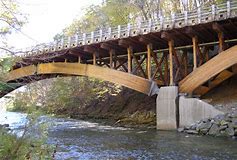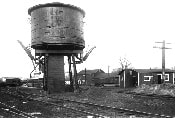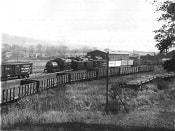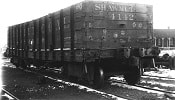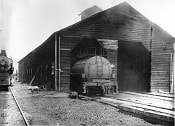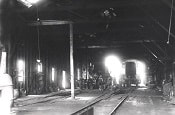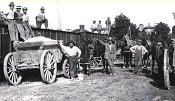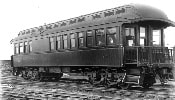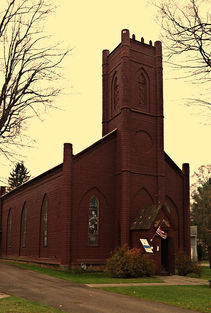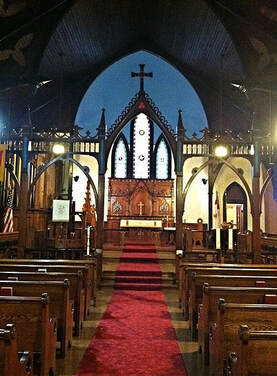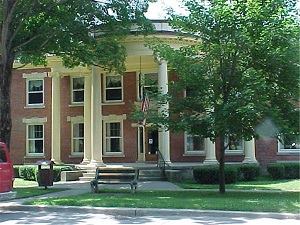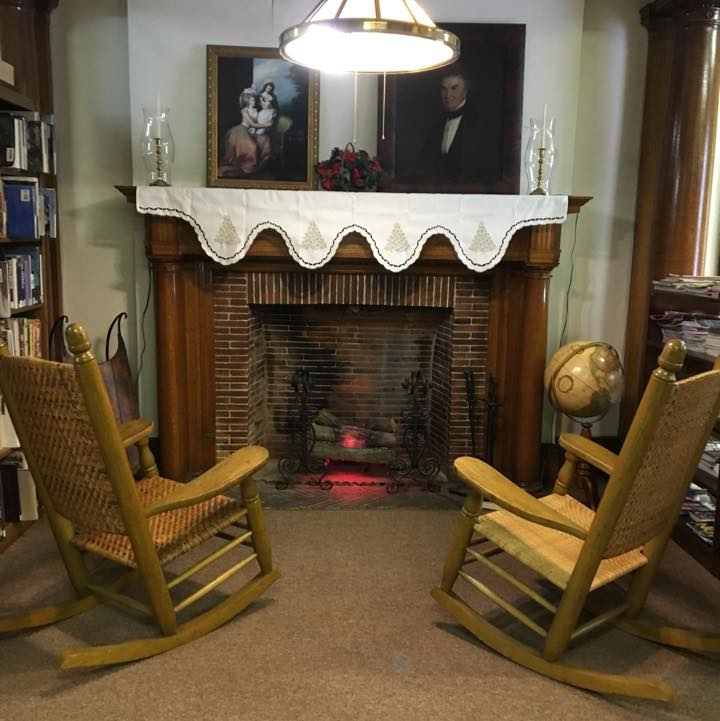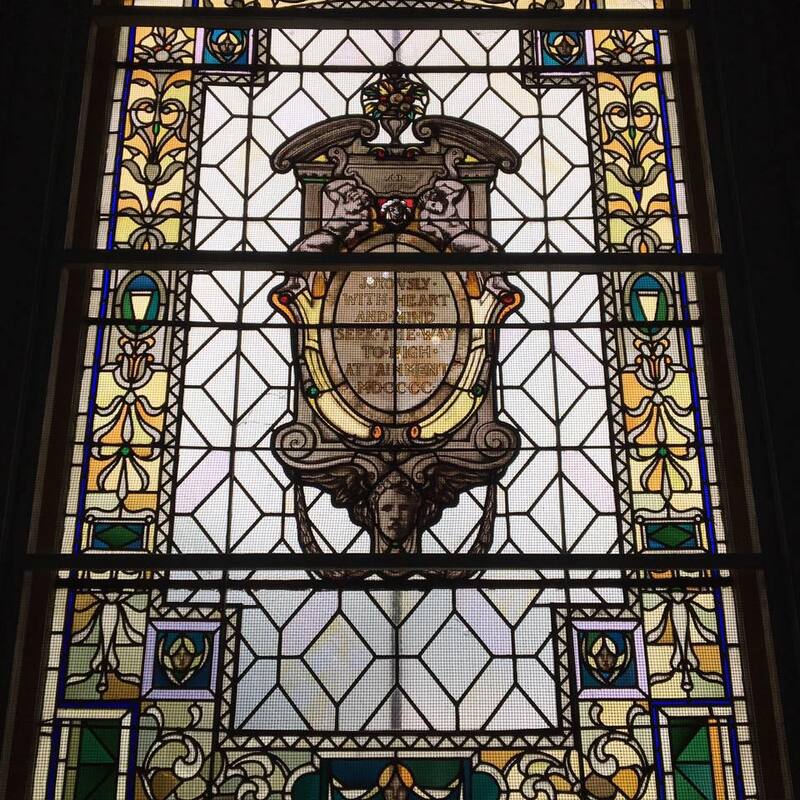Joncy Bridge [Legislator Alton Sylor Memorial]
“To compliment the natural beauty surrounding, the Alton Sylor Memorial Bridge in Allegany County, New York, a glue-laminated timber superstructure replaced a 1930s-era steel girder truss structure. The project designed by Dewberry’s earned a Gold Award for Engineering Excellence from the American Council Of Engineering Companies-NYS”. It is the longest clear span timber arch in the United States at 274.10 feet, constructed with 32 tons of lumber and 7 tons of steel. Built 39 feet over the Angelica Creek [which flows into the Genesee River] this unique and magnificent bridge opened to traffic June 25, 2003.
“To compliment the natural beauty surrounding, the Alton Sylor Memorial Bridge in Allegany County, New York, a glue-laminated timber superstructure replaced a 1930s-era steel girder truss structure. The project designed by Dewberry’s earned a Gold Award for Engineering Excellence from the American Council Of Engineering Companies-NYS”. It is the longest clear span timber arch in the United States at 274.10 feet, constructed with 32 tons of lumber and 7 tons of steel. Built 39 feet over the Angelica Creek [which flows into the Genesee River] this unique and magnificent bridge opened to traffic June 25, 2003.
Although the Erie Railroad had missed Angelica, the area was not without its own important railroad. Started in 1882, the Pittsburg, Shawmut & Northern railroad ran through 10 towns in the county, including Angelica. The Shawmut Shops were built in Angelica in 1884, and rebuilt a couple times due to fires in 1903 and 1918. "Angelica, economically, was a railroad economy," Mr. Haggstrom said. "The big dog, financially, during those years was the Shawmut Railroad. "At various times, over 130 men were employed by the railroad, and more than 40 Angelica residents had been employed in the administrative and operative departments. "People worked in the shops and on the tracks," Mr. Haggstrom said. "It was a (railroad) company town, essentially. A good number of people and families in Angelica today have ties to the railroad. "The trains supplied food for stores and also carried the mail. Passenger service discontinued in 1936, but the Shawmut remained as a freight, mail and coal carrier until March 31,1947, when it was officially abandoned.
According to "Allegany County in the 20th Century: Stories of Change," part of the problem was that the railroad didn't pass through any major industrial cities. Also, corporate offices were in St. Marys, Pa., while maintenance headquarters were in Angelica. The railroad went into receivership in 1903 and remained their until 1947, giving it two records: The greatest number of years in receivership and the largest percentage of its life in receivership.
According to "Allegany County in the 20th Century: Stories of Change," part of the problem was that the railroad didn't pass through any major industrial cities. Also, corporate offices were in St. Marys, Pa., while maintenance headquarters were in Angelica. The railroad went into receivership in 1903 and remained their until 1947, giving it two records: The greatest number of years in receivership and the largest percentage of its life in receivership.
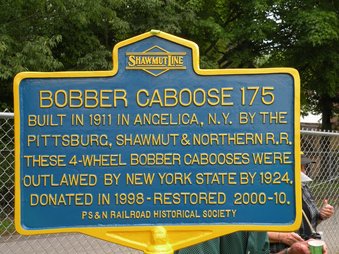
www.psnrrhs.org
The Pittsburg, Shawmut & Northern Railroad Company, also known as the "Shawmut Line," was a standard gauge, Class 1 Railroad company that operated both freight and passenger service from 1899 to 1947. Trackage extended from Wayland, NY to Brockway (nee Brockwayville), PA totaling approximately 190 miles. In addition, the railroad operated branches to Olean and Hornell, NY and to Hazelhurst, Cardiff, Drummond and Tyler, PA.
The purpose of this railroad was to haul coal from the mines of Elk (and later Jefferson) Counties in Pennsylvania to the Buffalo, Rochester and New York City areas in New York State.
The Pittsburg, Shawmut & Northern Railroad started its life on August 2, 1899 by the combination of five smaller, financially troubled, railroads in New York and Pennsylvania. These component rail lines were disconnected from each other and were comprised of a mixture of both narrow and standard gauges.
The principal shops were divided between Angelica, NY and St. Marys, PA. The Angelica Shops were used mostly as car repairs, painting and maintenance of way work with some repairs on motive power. Locomotives were maintained and repaired in St. Marys. Both shops burned over the years and were replaced. The Angelica Shops burned on May 23, 1918 and the St. Marys shops burned on March 20, 1941.
The Pittsburg, Shawmut & Northern Railroad Company, also known as the "Shawmut Line," was a standard gauge, Class 1 Railroad company that operated both freight and passenger service from 1899 to 1947. Trackage extended from Wayland, NY to Brockway (nee Brockwayville), PA totaling approximately 190 miles. In addition, the railroad operated branches to Olean and Hornell, NY and to Hazelhurst, Cardiff, Drummond and Tyler, PA.
The purpose of this railroad was to haul coal from the mines of Elk (and later Jefferson) Counties in Pennsylvania to the Buffalo, Rochester and New York City areas in New York State.
The Pittsburg, Shawmut & Northern Railroad started its life on August 2, 1899 by the combination of five smaller, financially troubled, railroads in New York and Pennsylvania. These component rail lines were disconnected from each other and were comprised of a mixture of both narrow and standard gauges.
The principal shops were divided between Angelica, NY and St. Marys, PA. The Angelica Shops were used mostly as car repairs, painting and maintenance of way work with some repairs on motive power. Locomotives were maintained and repaired in St. Marys. Both shops burned over the years and were replaced. The Angelica Shops burned on May 23, 1918 and the St. Marys shops burned on March 20, 1941.
Angelica Free Library and Colonial Rooms
|
The Angelica Free Library was dedicated in 1900, built with funds given by Clara Higgins Smith in memory of her mother. The Library reading and children’s rooms share the main floor space with the Colonial Rooms museum of local artifacts. Upstairs is an assembly hall used for plays and public gatherings. The Colonial Rooms are only open when trained docents are available. Please check the calendar or call the library for any special events.
|
HOURS:
Tuesday: 10am-7pm Wednesday: 1pm-7pm Thursday: 10am-3pm Saturday: 10am-3pm |
Contact Info
P.O. Box 660
55 West Main St
Angelica NY 14709
585-466-7860
P.O. Box 660
55 West Main St
Angelica NY 14709
585-466-7860

